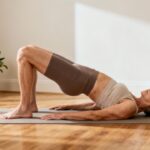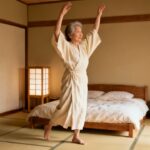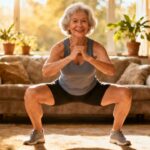What if you could build stronger, more stable knees without ever leaving your chair? For those over 60, the secret to lasting knee health might surprise you—it’s not about intense workouts or complicated movements, but about reconnecting your brain to your body through simple, seated exercises that build confidence from the ground up.
1. Seated Leg Kick: Rebuilding Brain-to-Knee Trust
Start by sitting tall near the edge of a firm chair with feet flat on the floor and knees bent at 90 degrees. Slowly extend your right leg forward, straightening the knee as much as comfortably possible. Hold for three seconds, then gently lower. Repeat on the other side, aiming for 10-20 reps per leg across 2-3 sets.
This exercise does more than strengthen your quadriceps—it retrains your brain to send clear signals to your knee joint. Over time, inactivity, arthritis, or past injuries can weaken this mind-movement connection. Each controlled leg kick rebuilds that trust, reducing the fear response that causes hesitation when standing or climbing stairs.
2. Isometric Press Down: Waking Up Hidden Support Systems
Scoot to the edge of your chair with both feet flat on the floor. Press your heels firmly into the ground as if trying to push the floor away, holding for three seconds before releasing. Repeat 10-12 times across 2-3 sets.
This invisible contraction activates deep stabilizers you don’t normally feel, training your nervous system to fire multiple muscle groups simultaneously. It builds the coordination needed for rising from chairs or stepping on curbs, providing weight-bearing benefits without joint stress.
3. Seated Side Step: Building Balance While Staying Grounded
From your seated position, slowly step your right foot out to the side, moving your knee and ankle together as if gliding outward. Return to center and alternate with your left leg. Complete 10-20 total reps across 2-3 sets.
This sideways movement targets your gluteus medius—the side hip stabilizer crucial for maintaining balance and preventing knee strain. It mimics real-life movements like stepping into cars or turning while holding groceries, training stability without standing up.
4. Inner Thigh Squeeze: Restoring Your Legs’ Forgotten Core
Place a firm pillow, yoga block, or rolled towel between your knees. Gently squeeze just enough to feel your inner thigh muscles activate, holding for three seconds before relaxing. Repeat 8-12 times across 2-3 sets.
This simple movement reawakens your adductors—muscles that control knee movement and prevent inward collapsing during walking. Strong inner thighs also support better posture, stronger steps, and even improved bladder control through their connection to your pelvic floor.
5. Heel and Toe Lifts: Strengthening Your Step One Lift at a Time
Sit comfortably with feet flat on the floor. Lift your heels while keeping toes down, then lower. Next, lift your toes while keeping heels planted. Alternate between heel and toe lifts for 10-20 total reps across 2-3 sets.
These lifts train your calves and shin muscles—essential for safe walking and preventing shuffling or tripping. They also act as a second heart for your lower body, pumping blood back toward your heart to improve circulation and reduce leg fatigue.
Making These Movements Work for You
Consistency matters more than intensity. Start with just 2-3 exercises 2-3 times weekly, focusing on how your body feels rather than perfect form. If movements feel easy, add longer holds or slight weights. If something feels off, scale back and give yourself grace.
Remember: this isn’t just exercise—it’s maintenance for the life you want to live. Whether gardening, traveling, dancing, or simply standing with confidence, these small moments build your foundation. You’re not just strengthening muscles; you’re strengthening self-belief.
Conclusion: Taking Back Control of Your Movement
These seated exercises may look simple, but they’re rewiring your nervous system, rebuilding confidence, and reigniting muscles that protect your knees and independence.
Aging doesn’t mean shrinking your world—it means adapting wisely and continuing to expand in new ways. With exercises like these, you’re not working against age but working with it—smarter, gentler, and just as powerful.
Keep showing up for yourself, because the most important thing about movement is that it keeps you moving forward—one confident step at a time.








